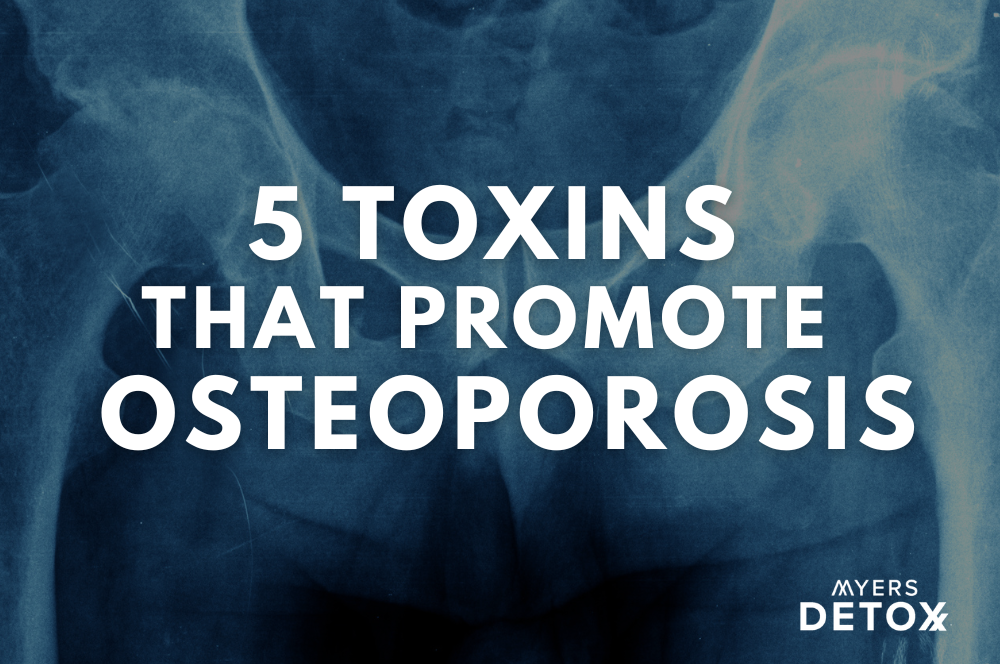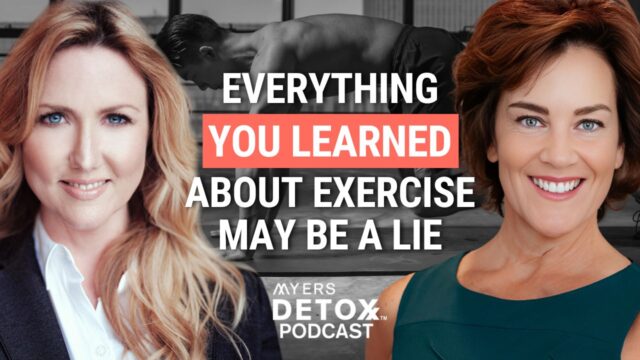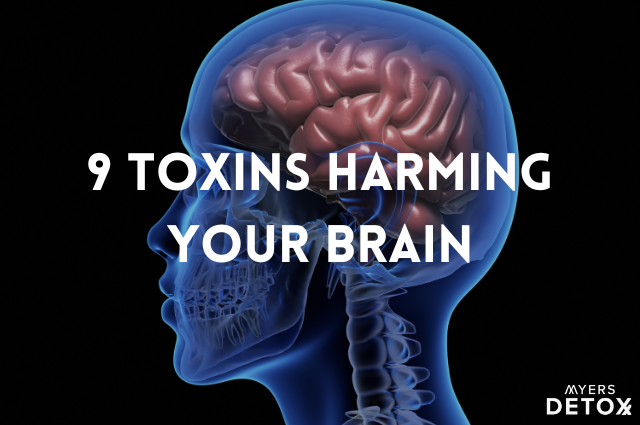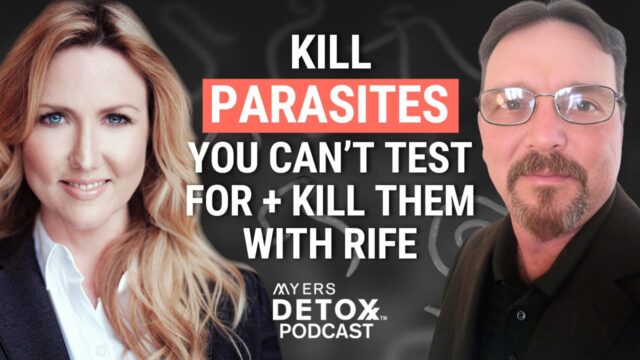Approximately 10 million Americans have osteoporosis, and half of all adults aged 50 and over are at risk for bone fractures[1]. Although bone loss is something that comes with age, these statistics clearly point to a more significant issue – our bones are disintegrating far too fast.
So what gives?
Along with the prevalence of bone disease, our environment has become a hotbed for toxic insults. Many toxins that you ingest (unknowingly) have an affinity for bone tissue or directly impact systems in your body related to bone building, such as your kidneys or endocrine system.
This doesn’t mean that you’re destined for brittle bones, but it is a wake-up call that we all need to be more aware of the toxicity in the environment and how it can impact bone tissue.
In this article, you’ll learn:
- The top 5 environmental toxins impacting bone health
- How heavy metals lodge themselves into your bone tissue and displace essential nutrients
- How plastics build up in your body and damage crucial hormones and organs that support bone building
- Which bone-damaging chemical can be found in 95% of Americans
- The silent toxin that no one is talking about that may be worse than all the others combined
- How to rebalance your mind-body system for healthier bones and overall well-being
Toxins Affecting Bone Health And Promoting Osteoporosis
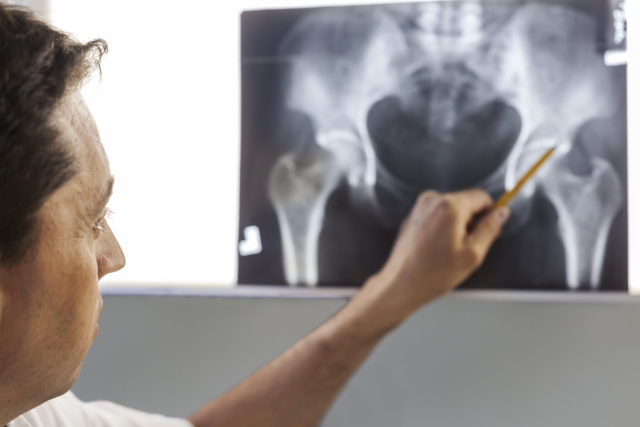
#1 Heavy Metals
Heavy metals are one of the most dangerous toxins for bones because they can lodge directly into your bone tissue and displace crucial nutrients necessary to maintain bone health, like calcium. At the same time, avoiding heavy metals can seem nearly impossible as these compounds can be found in everything from your drinking water and food to your beauty products and cleaning supplies.
Heavy metals are particularly dangerous because they can’t be detected in tests like urine, blood, or stool analysis because they’re directly incorporated into your bones.
Below are some of the most harmful heavy metals for bone health:
Lead
Lead is one of the trickiest metals because it weakens your bones and can’t be detected on x-rays or bone scans. It will, however, make your bones look more dense on Dexa Scans, mistakenly giving you confidence that your bone health is optimal when in fact, you are in great danger of fractures.
Unfortunately, when lead enters your body, it has a strong affinity for your bone tissue. In fact, around 90% of your body’s lead burden is hidden in your bones. To make matters worse, during menopause and andropause, when bone loss amps up, all that lead is released into your body. It’s no coincidence that this is also a time when diseases tend to show up[2].
Research shows that lead causes bone loss through three mechanisms[3][4]:
- Decreasing the formation of bone-building cells (osteoblasts)
- Facilitating bone-removing cells (osteoclasts)
- Inhibiting kidney conversion of vitamin D to its active form, thus impairing calcium absorption and deposition
To relieve your toxic burden of lead, the first thing you can do is to make sure your calcium stores are replete. When you add more calcium to your diet or supplement regimen, it can help to push lead out of your bones.
Aluminum
Much like lead, aluminum has a high affinity for your bone tissue and is all too happy to displace any minerals that you may be deficient in. And, of course, blood levels of aluminum are not a reliable source of information because this metal hides away in your tissues.
Aluminum also loves to accumulate over time; this is not a toxin that leaves your body willingly. As a result, years and years of low-level aluminum exposure can seriously threaten your bone health[5].
Similar to how calcium can replace lead, silica is an excellent nutrient for replacing aluminum in your bones. A high-quality silica supplement can help promote your body’s natural detox process in gently release excess aluminum while contributing to your bone strength.*
Mercury
Mercury not only has an affinity for your bone tissue, but it also loves to deposit in connective tissues that impact the health of your bones. Research shows that high levels of mercury may contribute to autoimmune diseases that affect bone and connective tissue, such as rheumatoid arthritis. Furthermore, the inflammatory impact of mercury can set the stage for osteoarthritis. Both of these conditions can drastically impact your quality of life and increase the risk for osteoporosis[6][7].
Cadmium
Cadmium accumulates in your bones and kidneys, both directly and indirectly affecting bone health.
For example, due to its impact on your kidneys, cadmium can impair key kidney functions and damage osteoblast cells (the bone cells responsible for building strong bones). Cadmium also poisons a crucial enzyme that converts vitamin D to its active form in the kidneys, impairing calcium uptake.
Furthermore, cadmium damages your kidney’s ability to excrete toxins, which makes it even harder for your body to rid itself of unwanted metals[2].
Supporting your body in the natural clearing of heavy metals is no small feat, and you want to make sure that when you do go about detoxing metals, you have full detoxification support. Many detox programs will upregulate your ability to remove metals from your cells, but they don’t help you escort those toxins out of your body. The result? A bunch of heavy metals floating around in your blood, lodging into your tissues and creating even more damage.
That’s why I put together CitriCleanse Toxin Binder. This formula gently allows your body to naturally remove unwanted toxins and then seals the deal by assisting with their removal from your blood.*
#2 Pesticides
Pesticides are coming under more and more scrutiny as these chemical compounds continue to show up as causes and contributors to a range of health conditions. Currently, more than 70% of non-organic produce in the US contains traces of pesticides, which means that even the most careful among us are likely consuming more pesticides than we even realize[8].
One way in which pesticides damage your cells and tissues is by increasing oxidative stress. Oxidative stress initiates a cascade of inflammatory chemicals, which raises systemic inflammation and directly impacts bone health and remodeling.
Pesticides can also cause kidney damage, significantly increasing your risk of osteoporosis due to the intimate relationship your bone health has with kidney function[2].
While avoiding pesticides completely may be impossible, choosing organic food as much as possible is the most straightforward way to avoid an overload of these toxins.
#3 Phthalates
Phthalates are plasticizers that make plastic soft, increasing flexibility and durability. They’re present in a wide range of products, including water bottles, children’s toys, containers, food packaging, and food additives – to name a few.
Plasticizers decrease circulating levels of vitamin D and increase your risk for a vitamin D deficiency by 20%. This is particularly significant given that vitamin D deficiency is already so common. When vitamin D is deficient, it inhibits proper calcium utilization, making your bones weaker and more prone to fracture[9].
Studies show a direct correlation between blood levels of phthalates and lower bone mineral density, putting you at risk for osteoporosis[10].
#4 Bisphenols (BPA)
Much like phthalates, bisphenols are plasticizers that are added to a range of products, except these compounds make plastics more solid and hard. BPA is used in a range of manufacturing processes and can be widely found in the packaged food industry. In fact, the main route for exposure is through our water and food supply.
In a frightening statistic, research shows that up to 90% of the US population has detectable levels of BPA in their bodies.
BPA impacts bone health in several ways[11][12][13]:
- It shuts down an important enzyme for osteoblast (bone building) function.
- It inhibits the secretion of calcitonin, an enzyme that instructs your bones to stop releasing their calcium stores.
- It encourages apoptosis in osteoblast cells (cell death), inhibiting bone renewal.
- It acts as an endocrine disruptor, dysregulating estrogen activity, which is crucial for both osteoclast and osteoblast activity, impairing the entire bone remodeling process.
For both phthalates and BPA, awareness is the key to avoiding toxic consumption. While many companies still use these compounds, you can find alternatives to many of your plastic wear that will directly state “BPA and phthalate-free.” Furthermore, if you really want to do good by yourself and the environment, you can opt-out of plastic as much as possible and use refillable containers[2].
#5 Perfluoroalkyl Substances (PFAS)
PFAS are a class of compounds that are widely used as protective coatings for water and stain-resistant clothing, furnishings, and non-stick cookware. These compounds are known endocrine disruptors, and yet they are still allowed to be used in many different manufacturing processes.
As endocrine-disrupting chemicals, PFAS can disturb your body’s estrogen activity, which, as mentioned, has a direct impact on bone health. In fact, research shows an inverse relationship between levels of PFAS in the body and bone mineral density. And unfortunately, it is estimated that around 95% of people in the US have detectable PFAS levels[14][15].
To avoid PFAS, watch out for non-stick coatings (especially on cookware), and prevent stain or water-repellent clothing and furnishings as much as possible.
Emotional Toxicity As A Hidden Factor

The above toxins can have obvious and straightforward impacts on your bone health and quality. And the good news is that because they are physical compounds, you can make conscious steps to avoid or limit your exposure and protect your bones.
Unfortunately, there is another toxin that is impacting your bone health that is a little less obvious – emotional stress.
So many people spend years, or even decades, looking for the physical roots of their health issues while completely ignoring their emotional world. Although it may not seem like our emotional states come and go without much impact on our physical health, nothing could be further from the truth.
In fact, studies show that emotional trauma can make you much more likely to experience chronic illness due to an upsurge in inflammation as well as immune dysregulation[16].
But can untreated emotional pain actually impact your bones? The research says a resounding yes.
For example[17][18][19][20]:
- One study found that psychological stress can greatly impact your risk of developing osteoporosis.
- US military veterans diagnosed with PTSD have a higher risk of developing osteoporosis.
- Holocaust survivors have a 3.4-fold increased risk for bone disease.
- Psychological stress can increase systemic inflammation, directly impacting bone health.
- Psychological stress can increase osteoclast differentiation (increasing bone loss)
- Chronic stress can dysregulate the activity of key bone-health hormones like insulin-like growth factor (IGF-1), which is crucial for maintaining strong bones throughout the life cycle.
Need I go on?
The truth is that while physical inputs certainly impact our physical bodies, the mind-body connection cannot be downplayed. For thousands of years, the impact that our mental and emotional state had on our physical well-being was respected and understood. Ancient systems of medicine like Traditional Chinese Medicine and Ayurveda understood how powerful our minds are and incorporated practices for enhancing the health of the mental field, along with physical health.
This is a practice that has been wiped out due to modern medicine, but only to our detriment.
Experts in the field of mind-body medicine understand that different emotional states can impact your body in various ways. For instance, holding on to anger can impact the health of your liver, while refusing to grieve can create issues with your lungs and respiratory health. For your bones, the most damaging emotional state is self-devaluation.
Whether this came from childhood experiences of being told you were not good enough or you internally created a belief of unworthiness that was reinforced by the behaviors of others, not valuing yourself is one of the most harmful things you can do to your structural support system – your bones.
Emotional Detox: Releasing The Old Story For A Healthier Future
So, how do you go about changing this belief? How can you detoxify the lie that you’re not of value?
Removing unwanted beliefs can be both complicated and yet incredibly easy. Complicated because you must consider how this belief drives your behaviors, mindset, physical health, and even your energetic field. Easy because once you decide to change it, there are many tools that can help you unweave the story you’ve been telling yourself all of your life.
Your highest self, your soul, or whatever term resonates with you, knows the truth of your worthiness and the unique energy you contribute to this world. Once this part of you gets the mic, the road to healing starts to unfold seamlessly.
Many people try to grapple with their emotions head-on in therapy, talking through and reasoning why they have been through the challenges of their life and looking for meaning. But, unfortunately, this rarely produces sustainable results because the wiring goes so deep into their psyche.
Other people will skip the therapy and go straight to an energy healer. The assumption is that if we get our energy into alignment, all else will fall into place. While there is some truth in this, your mind is a powerful tool, and if you have yet to release your limiting thoughts fully, it will drag your energy back down.
Through years of research, I’ve found two things to be true about healing:
- It takes a concerted effort of mind, body, and energy to heal at the root level
- Putting your ability to heal in someone else’s hands only disempowers you in the future
I created my Emotional Detox Program to address all levels of mind-body-energy where your trauma and limiting beliefs are held. This program gives you the tools that you need to work through whatever is happening for you right now and sustain your personal power for whatever should come your way in the future.
The only predictable thing in life is that it will always be unpredictable. But that does not mean you’re powerless over what life offers you.
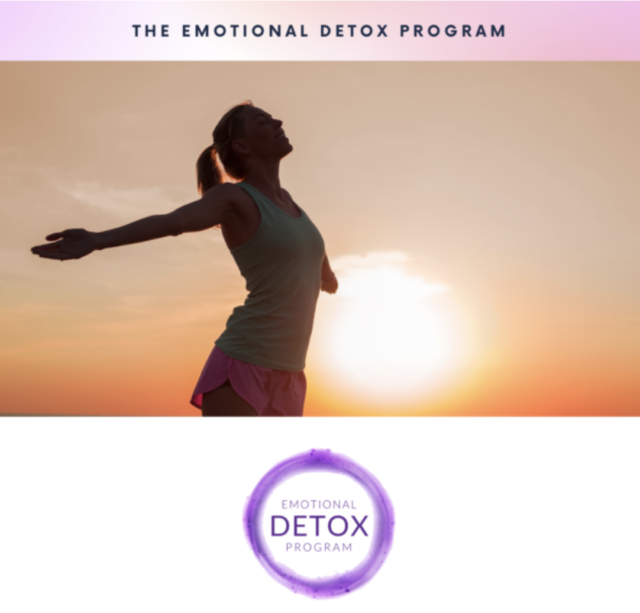 Going through my Emotional Detox Program will help you reclaim that inner knowing that allows you to feel love, joy, and excitement in your day to day. This life is a gift, and there is so much to celebrate; we just need the tools to tackle the obstacles that try to get in our way.
Going through my Emotional Detox Program will help you reclaim that inner knowing that allows you to feel love, joy, and excitement in your day to day. This life is a gift, and there is so much to celebrate; we just need the tools to tackle the obstacles that try to get in our way.
Takeaway
Osteoporosis is a condition that primarily affects the older generation, but the damaging impact of environmental and emotional toxins can start at any age. In other words, it’s never too early to start paying attention to bone health.
Avoiding pesticides, plastics, non-stick cookware, and sources of heavy metals is a great place to start, but the real work is an inside job. To clear your body of toxins, you must look at your toxic beliefs and unresolved traumas. Specifically, ask yourself, “do I feel worthy of living a healthy life?”
Far too many people are stuck in a trap of unworthiness that holds them back from living out their most purposeful and joyful life. Once this belief is eliminated, finding the inner resources for true health and healing becomes second nature.
To learn how to uproot limiting beliefs like unworthiness, check out my Emotional Detox Program.
*These statements have not been reviewed by the FDA. These products are not intended to diagnose, treat, cure, or prevent any disease. They are not intended to replace any medication or healing modality prescribed by your medical doctor.


